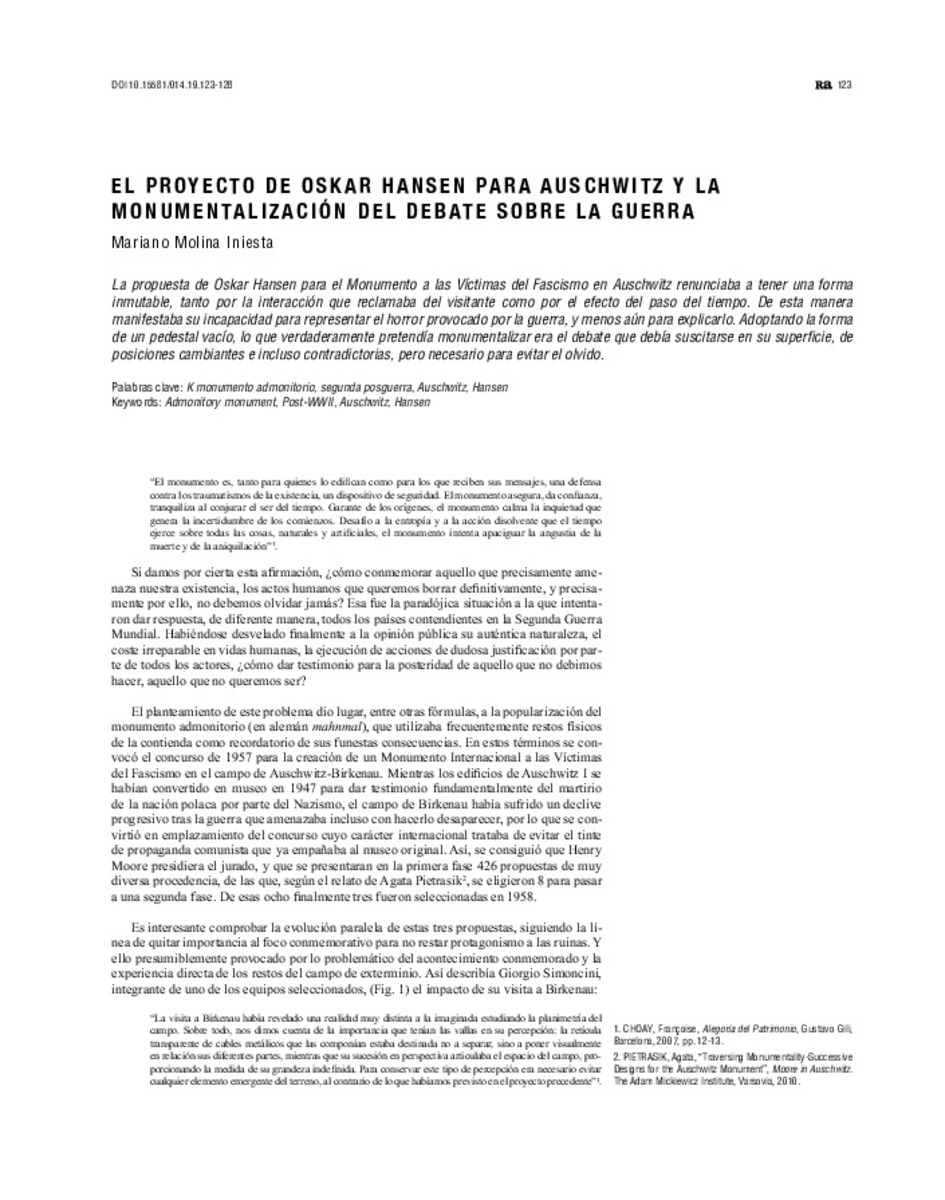Full metadata record
| DC Field | Value | Language |
|---|---|---|
| dc.creator | Molina Iniesta, M. (Mariano) | - |
| dc.date.accessioned | 2019-01-10T08:45:46Z | - |
| dc.date.available | 2019-01-10T08:45:46Z | - |
| dc.date.issued | 2017 | - |
| dc.identifier.citation | Molina Iniesta, M. (Mariano). "El proyecto de Oskar Hansen para Auschwitz y la monumentalización del debate sobre la guerra". Ra. Revista de Arquitectura. 19, 2017, 123 - 128 | es |
| dc.identifier.issn | 1138-5596 | - |
| dc.identifier.uri | https://hdl.handle.net/10171/56189 | - |
| dc.description.abstract | La propuesta de Oskar Hansen para el Monumento a las Víctimas del Fascismo en Auschwitz renunciaba a tener una forma inmutable, tanto por la interacción que reclamaba del visitante como por el efecto del paso del tiempo. De esta manera manifestaba su incapacidad para representar el horror provocado por la guerra, y menos aún para explicarlo. Adoptando la forma de un pedestal vacío, lo que verdaderamente pretendía monumentalizar era el debate que debía suscitarse en su superficie, de posiciones cambiantes e incluso contradictorias, pero necesario para evitar el olvido. | - |
| dc.description.abstract | Oskar Hansen’s proposal for the Memorial to the Victims of Fascism in Auschwitz renounced to have an immutable shape, both because of the interaction it claimed from the visitor and the effect of the passage of time. Devoid of a focus for commemoration and surrounded by remnants of the camp that were meant to acquire a romantic outlook in the future, it proclaimed its inability to depict the horror provoked by the war, let alone to explain it. Its transgressor character aroused the suspicion of the victims, who did not feel themselves represented on Hansen’s empty pedestal. Its novelty was based on shifting the burden of memory from the object ( the traditional monument) to the subject ( the viewer), as Postmodernism would do later, and stimulating critical thinking about the past. But above all, and because of its reluctance to ‘ talk’, it aspired to remain a valid space for remembrance, regardless of the transformations that postwar society’s relationship with the architectural heritage of Nazism went through. This relationship has been swinging like a pendulum over the years, first ignoring or underplaying the symbolic power of these buildings. Later on, when German society felt ready to ‘ come to terms with the past’, almost every trace of Nazism was deemed worthy of preservation, and the birth of the countermonument ( many of which literally replicated the mechanisms that Hansen put in place in Auschwitz) helped to shape a critical review of this period. And finally, it seems that the excess of memory during the last decades of the twentieth century is giving way to the normalization of this legacy as just one more element in the urban landscape. Given the changing nature of these attitudes, rather than a specific response, what Hansen really intended to monumentalize was the debate that should be fostered on the surface of his monument, as an antidote to oblivion. | - |
| dc.language.iso | spa | - |
| dc.publisher | Servicio de Publicaciones de la Universidad de Navarra | - |
| dc.rights | info:eu-repo/semantics/openAccess | - |
| dc.subject | K monumento admonitorio | - |
| dc.subject | segunda posguerra | - |
| dc.subject | Auschwitz | - |
| dc.subject | Hansen, J. A. (Joao Adolfo) | - |
| dc.subject | Admonitory monument | - |
| dc.subject | Post-WWII | - |
| dc.subject | Auschwitz | - |
| dc.subject | Hansen, J. A. (Joao Adolfo) | - |
| dc.title | El proyecto de Oskar Hansen para Auschwitz y la monumentalización del debate sobre la guerra | - |
| dc.title.alternative | Oskar Hansen's design for Auschwitz and the monumentalization of the debate about the war | - |
| dc.type | info:eu-repo/semantics/article | - |
| dc.identifier.doi | 10.15581/014.19.123-128 | - |
| dadun.citation.endingPage | 128 | - |
| dadun.citation.publicationName | Ra. Revista de Arquitectura | - |
| dadun.citation.startingPage | 123 | - |
| dadun.citation.volume | 19 | - |
| dc.date.updated | 2019-01-10T08:45:46Z | - |
| dc.description.version | Peer Reviewed | - |
Files in This Item:
Statistics and impact
Items in Dadun are protected by copyright, with all rights reserved, unless otherwise indicated.






